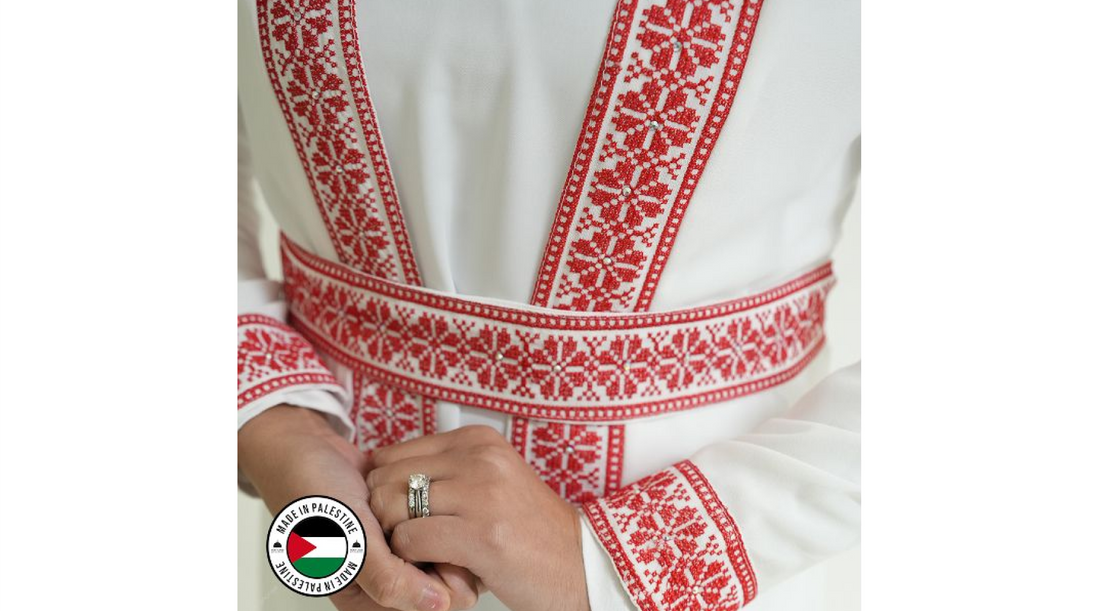
The Cultural Significance of Palestinian Clothing During Eid
“Identity is what we pass on, not what we inherit.” – Mahmoud Darwish, renowned Palestinian poet
For generations, Palestinian women have passed down more than just fabric — they’ve preserved history, identity, and resilience through every stitch of their traditional dress, known as the thobe. These dresses are not only beautiful garments but powerful symbols of belonging, memory, and resistance.
Wearing the thobe during Eid — one of the holiest occasions for Muslims — is more than a fashion statement. It’s a declaration of cultural pride, spiritual connection, and solidarity with Palestine. When you wear a piece stitched with heritage from the Holy Land, you carry a story of struggle, strength, and hope.
A Living Symbol of Heritage
The traditional Palestinian dress, or thobe, is much more than clothing — it reflects Palestinian heritage. Rich in colour and detail, each thobe is hand-embroidered with motifs unique to the region it comes from, preserving generations of local customs and stories in every thread.
It is typically a long gown with full-length sleeves, often accompanied by accessories such as a matching shawl or embroidered belt. These garments celebrate femininity, strength, and identity, passed down from mother to daughter with love and pride.
Regional Styles: A Dress for Every City
While united by meaning, the thobe takes on distinct styles across different cities and villages in Palestine. Each embroidery pattern tells the story of its people and their connection to the land:
Bethlehem Style: Renowned for its lavish golden embroidery and intricate symbols, making it one of the most elegant and luxurious designs.
Gaza Style: Bright and bold, with geometric patterns and simple yet powerful lines that reflect the region’s vibrant spirit.
Jerusalem Style: Deep, dark tones paired with rich embroidery reflect the city’s ancient history and spiritual depth.
Hebron Style: Heavy fabrics and earthy colours mirror the agricultural and industrial nature of the area.
Nablus Style: Softer in colour and design, reflecting the mountainous terrain and peaceful surroundings.
These designs are more than aesthetic — they’re a visual language of identity, pride, and rootedness.
Why Wear a Palestinian Thobe for Eid?
Eid is a time of reflection, worship, and celebration. It’s a chance to honour Allah’s blessings and remember the values of sacrifice, unity, and compassion. As mentioned in the Qur'an:
“And whoever honours the symbols of Allah – indeed, it is from the piety of hearts.” (Surah Al-Hajj, 22:32)
Eid al-Adha, in particular, commemorates the willingness of Prophet Ibrahim (AS) to sacrifice his son in obedience to Allah — a powerful reminder of faith and devotion.
But in today’s world, while Muslims prepare for joy, our hearts are heavy for Palestine, where innocent lives continue to be lost and basic rights denied. Amid this pain, wearing the Palestinian thobe on Eid becomes an act of solidarity. It’s a way to honour Palestinian culture during sacred moments, to say: You are not forgotten.
By choosing to wear the thobe this Eid, you embrace more than elegance — you carry history, uplift voices, and express loyalty to a cause that transcends borders. It is a quiet yet powerful reminder that even in celebration, our hearts beat with the people of Palestine.
At Holy Land Dates, we are proud to offer a selection of authentic Palestinian dresses, brought directly from Palestine. Each piece represents a unique regional style, handcrafted with care and meaning. By wearing one, you not only honour tradition, you support Palestinian artisans and keep their heritage alive.